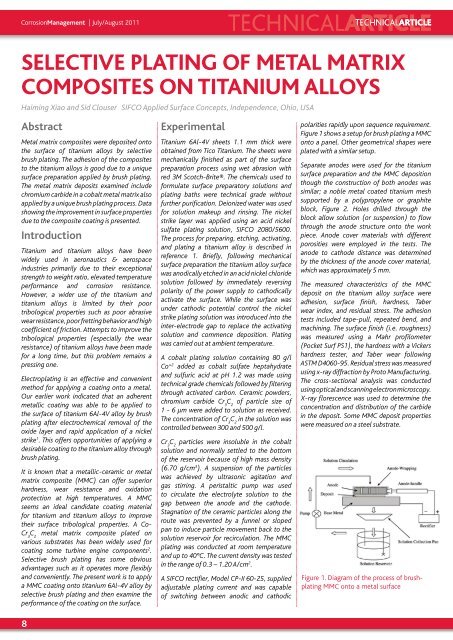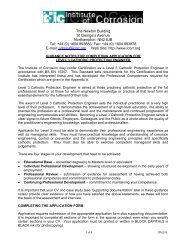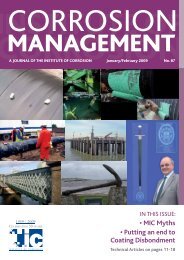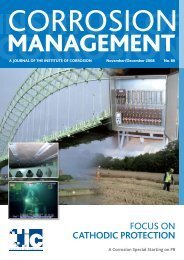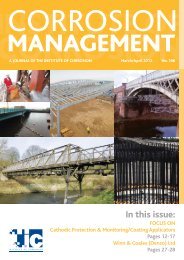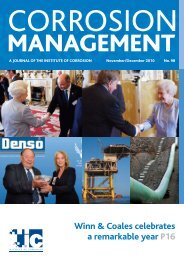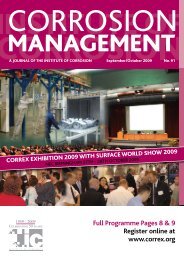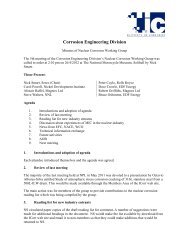In this issue: - the Institute of Corrosion
In this issue: - the Institute of Corrosion
In this issue: - the Institute of Corrosion
Create successful ePaper yourself
Turn your PDF publications into a flip-book with our unique Google optimized e-Paper software.
<strong>Corrosion</strong>Management | July/August 2011<br />
TECHNICALARTICLE<br />
Selective Plating <strong>of</strong> Metal Matrix<br />
Composites on Titanium Alloys<br />
Haiming Xiao and Sid Clouser SIFCO Applied Surface Concepts, <strong>In</strong>dependence, Ohio, USA<br />
Abstract<br />
Metal matrix composites were deposited onto<br />
<strong>the</strong> surface <strong>of</strong> titanium alloys by selective<br />
brush plating. The adhesion <strong>of</strong> <strong>the</strong> composites<br />
to <strong>the</strong> titanium alloys is good due to a unique<br />
surface preparation applied by brush plating.<br />
The metal matrix deposits examined include<br />
chromium carbide in a cobalt metal matrix also<br />
applied by a unique brush plating process. Data<br />
showing <strong>the</strong> improvement in surface properties<br />
due to <strong>the</strong> composite coating is presented.<br />
<strong>In</strong>troduction<br />
Titanium and titanium alloys have been<br />
widely used in aeronautics & aerospace<br />
industries primarily due to <strong>the</strong>ir exceptional<br />
strength to weight ratio, elevated temperature<br />
performance and corrosion resistance.<br />
However, a wider use <strong>of</strong> <strong>the</strong> titanium and<br />
titanium alloys is limited by <strong>the</strong>ir poor<br />
tribological properties such as poor abrasive<br />
wear resistance, poor fretting behavior and high<br />
coefficient <strong>of</strong> friction. Attempts to improve <strong>the</strong><br />
tribological properties (especially <strong>the</strong> wear<br />
resistance) <strong>of</strong> titanium alloys have been made<br />
for a long time, but <strong>this</strong> problem remains a<br />
pressing one.<br />
Electroplating is an effective and convenient<br />
method for applying a coating onto a metal.<br />
Our earlier work indicated that an adherent<br />
metallic coating was able to be applied to<br />
<strong>the</strong> surface <strong>of</strong> titanium 6Al-4V alloy by brush<br />
plating after electrochemical removal <strong>of</strong> <strong>the</strong><br />
oxide layer and rapid application <strong>of</strong> a nickel<br />
strike 1 . This <strong>of</strong>fers opportunities <strong>of</strong> applying a<br />
desirable coating to <strong>the</strong> titanium alloy through<br />
brush plating.<br />
It is known that a metallic-ceramic or metal<br />
matrix composite (MMC) can <strong>of</strong>fer superior<br />
hardness, wear resistance and oxidation<br />
protection at high temperatures. A MMC<br />
seems an ideal candidate coating material<br />
for titanium and titanium alloys to improve<br />
<strong>the</strong>ir surface tribological properties. A Co-<br />
Cr 3<br />
C 2<br />
metal matrix composite plated on<br />
various substrates has been widely used for<br />
coating some turbine engine components 2 .<br />
Selective brush plating has some obvious<br />
advantages such as it operates more flexibly<br />
and conveniently. The present work is to apply<br />
a MMC coating onto titanium 6Al-4V alloy by<br />
selective brush plating and <strong>the</strong>n examine <strong>the</strong><br />
performance <strong>of</strong> <strong>the</strong> coating on <strong>the</strong> surface.<br />
8<br />
Experimental<br />
Titanium 6Al-4V sheets 1.1 mm thick were<br />
obtained from Tico Titanium. The sheets were<br />
mechanically finished as part <strong>of</strong> <strong>the</strong> surface<br />
preparation process using wet abrasion with<br />
red 3M Scotch-Brite®. The chemicals used to<br />
formulate surface preparatory solutions and<br />
plating baths were technical grade without<br />
fur<strong>the</strong>r purification. Deionized water was used<br />
for solution makeup and rinsing. The nickel<br />
strike layer was applied using an acid nickel<br />
sulfate plating solution, SIFCO 2080/5600.<br />
The process for preparing, etching, activating,<br />
and plating a titanium alloy is described in<br />
reference 1. Briefly, following mechanical<br />
surface preparation <strong>the</strong> titanium alloy surface<br />
was anodically etched in an acid nickel chloride<br />
solution followed by immediately reversing<br />
polarity <strong>of</strong> <strong>the</strong> power supply to cathodically<br />
activate <strong>the</strong> surface. While <strong>the</strong> surface was<br />
under cathodic potential control <strong>the</strong> nickel<br />
strike plating solution was introduced into <strong>the</strong><br />
inter-electrode gap to replace <strong>the</strong> activating<br />
solution and commence deposition. Plating<br />
was carried out at ambient temperature.<br />
A cobalt plating solution containing 80 g/l<br />
Co +2 added as cobalt sulfate heptahydrate<br />
and sulfuric acid at pH 1.2 was made using<br />
technical grade chemicals followed by filtering<br />
through activated carbon. Ceramic powders,<br />
chromium carbide Cr 3<br />
C 2<br />
<strong>of</strong> particle size <strong>of</strong><br />
1 - 6 μm were added to solution as received.<br />
The concentration <strong>of</strong> Cr 3<br />
C 2<br />
in <strong>the</strong> solution was<br />
controlled between 300 and 500 g/l.<br />
Cr 3<br />
C 2<br />
particles were insoluble in <strong>the</strong> cobalt<br />
solution and normally settled to <strong>the</strong> bottom<br />
<strong>of</strong> <strong>the</strong> reservoir because <strong>of</strong> high mass density<br />
(6.70 g/cm 3 ). A suspension <strong>of</strong> <strong>the</strong> particles<br />
was achieved by ultrasonic agitation and<br />
gas stirring. A peristaltic pump was used<br />
to circulate <strong>the</strong> electrolyte solution to <strong>the</strong><br />
gap between <strong>the</strong> anode and <strong>the</strong> cathode.<br />
Stagnation <strong>of</strong> <strong>the</strong> ceramic particles along <strong>the</strong><br />
route was prevented by a funnel or sloped<br />
pan to induce particle movement back to <strong>the</strong><br />
solution reservoir for recirculation. The MMC<br />
plating was conducted at room temperature<br />
and up to 40°C. The current density was tested<br />
in <strong>the</strong> range <strong>of</strong> 0.3 – 1.20 A/cm 2 .<br />
A SIFCO rectifier, Model CP-II 60-25, supplied<br />
adjustable plating current and was capable<br />
<strong>of</strong> switching between anodic and cathodic<br />
polarities rapidly upon sequence requirement.<br />
Figure 1 shows a setup for brush plating a MMC<br />
onto a panel. O<strong>the</strong>r geometrical shapes were<br />
plated with a similar setup.<br />
Separate anodes were used for <strong>the</strong> titanium<br />
surface preparation and <strong>the</strong> MMC deposition<br />
though <strong>the</strong> construction <strong>of</strong> both anodes was<br />
similar; a noble metal coated titanium mesh<br />
supported by a polypropylene or graphite<br />
block, Figure 2. Holes drilled through <strong>the</strong><br />
block allow solution (or suspension) to flow<br />
through <strong>the</strong> anode structure onto <strong>the</strong> work<br />
piece. Anode cover materials with different<br />
porosities were employed in <strong>the</strong> tests. The<br />
anode to cathode distance was determined<br />
by <strong>the</strong> thickness <strong>of</strong> <strong>the</strong> anode cover material,<br />
which was approximately 5 mm.<br />
The measured characteristics <strong>of</strong> <strong>the</strong> MMC<br />
deposit on <strong>the</strong> titanium alloy surface were<br />
adhesion, surface finish, hardness, Taber<br />
wear index, and residual stress. The adhesion<br />
tests included tape-pull, repeated bend, and<br />
machining. The surface finish (i.e. roughness)<br />
was measured using a Mahr pr<strong>of</strong>ilometer<br />
(Pocket Surf PS1), <strong>the</strong> hardness with a Vickers<br />
hardness tester, and Taber wear following<br />
ASTM D4060-95. Residual stress was measured<br />
using x-ray diffraction by Proto Manufacturing.<br />
The cross-sectional analysis was conducted<br />
using optical and scanning electron microscopy.<br />
X-ray florescence was used to determine <strong>the</strong><br />
concentration and distribution <strong>of</strong> <strong>the</strong> carbide<br />
in <strong>the</strong> deposit. Some MMC deposit properties<br />
were measured on a steel substrate.<br />
Figure 1. Diagram <strong>of</strong> <strong>the</strong> process <strong>of</strong> brushplating<br />
MMC onto a metal surface


